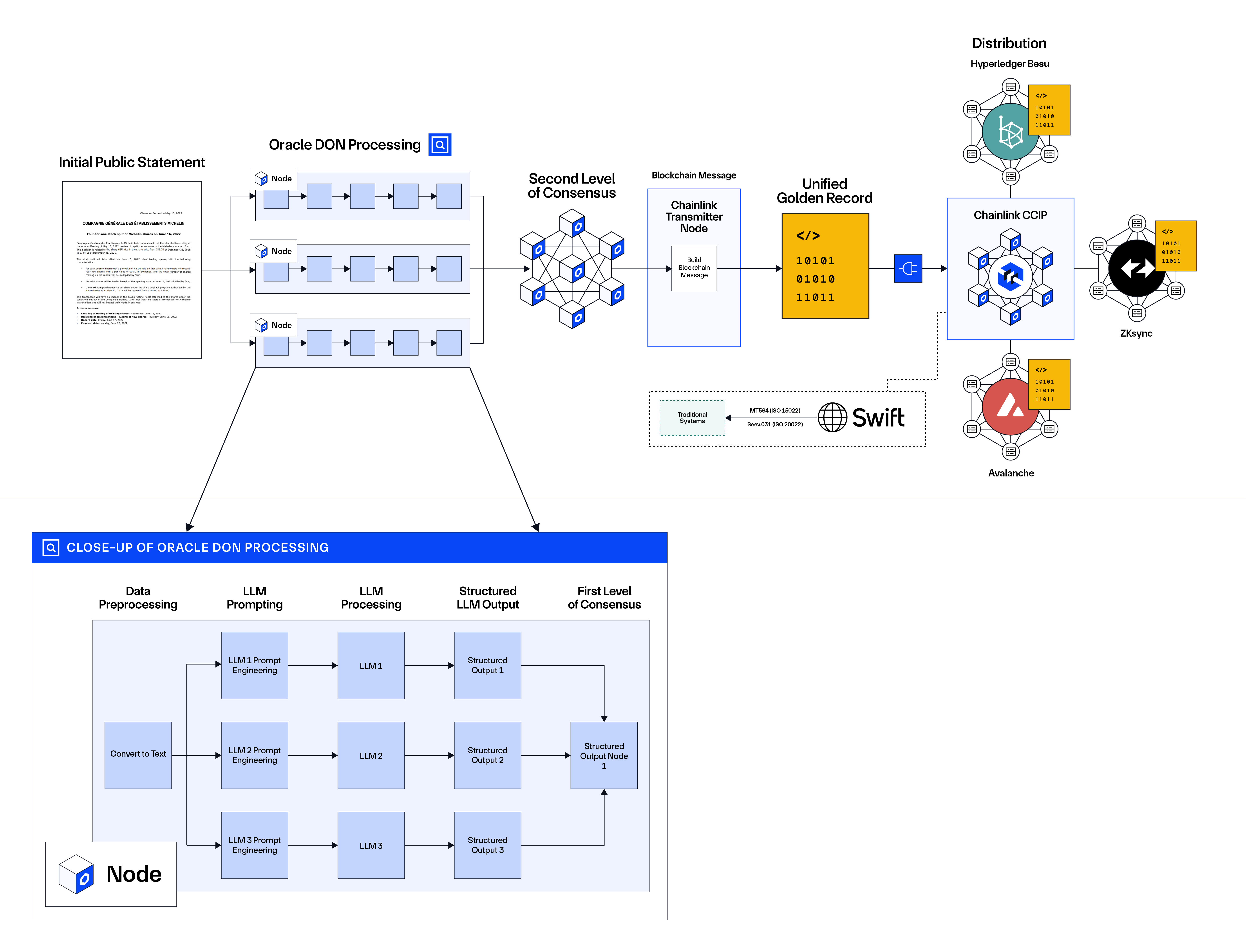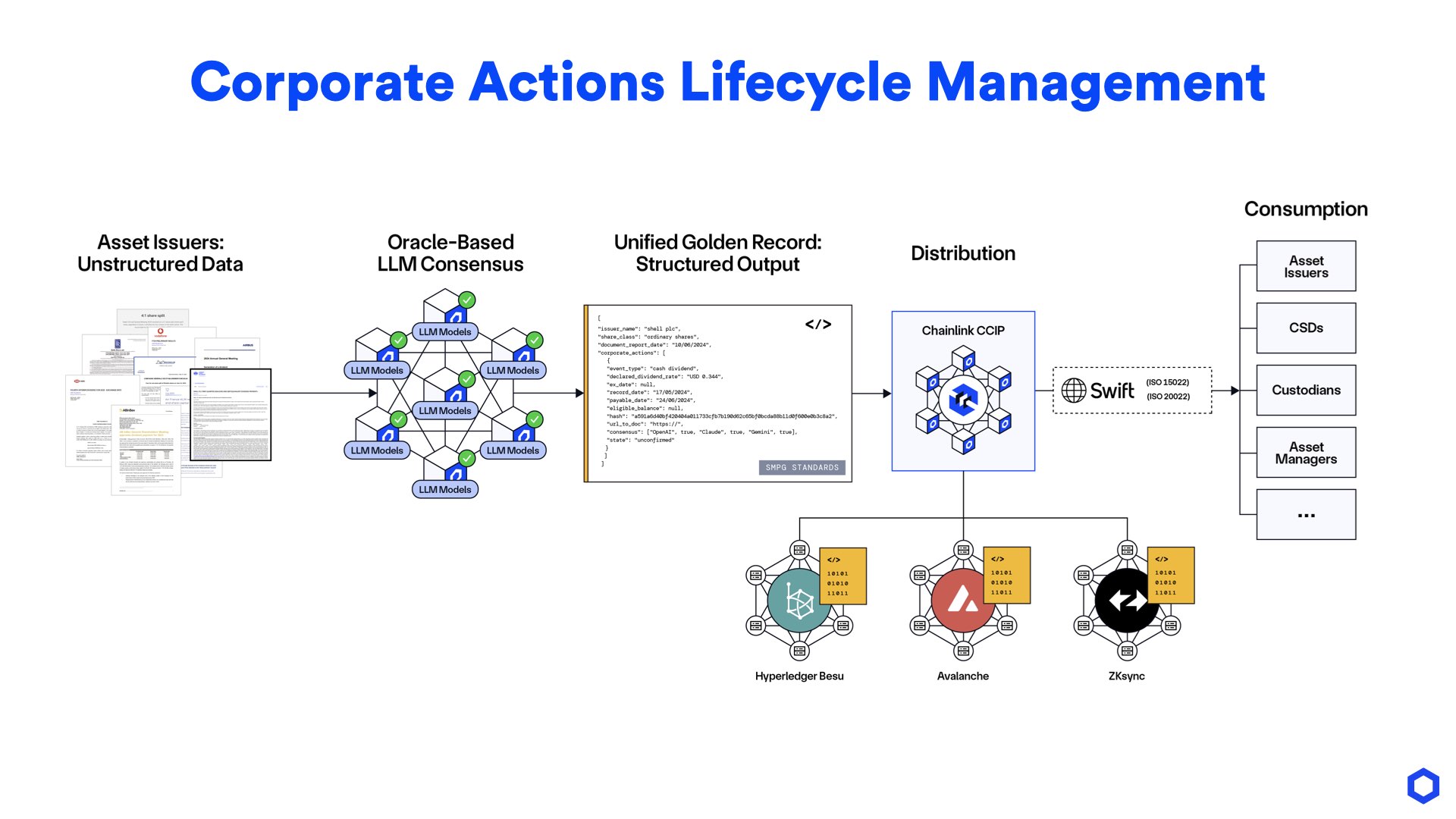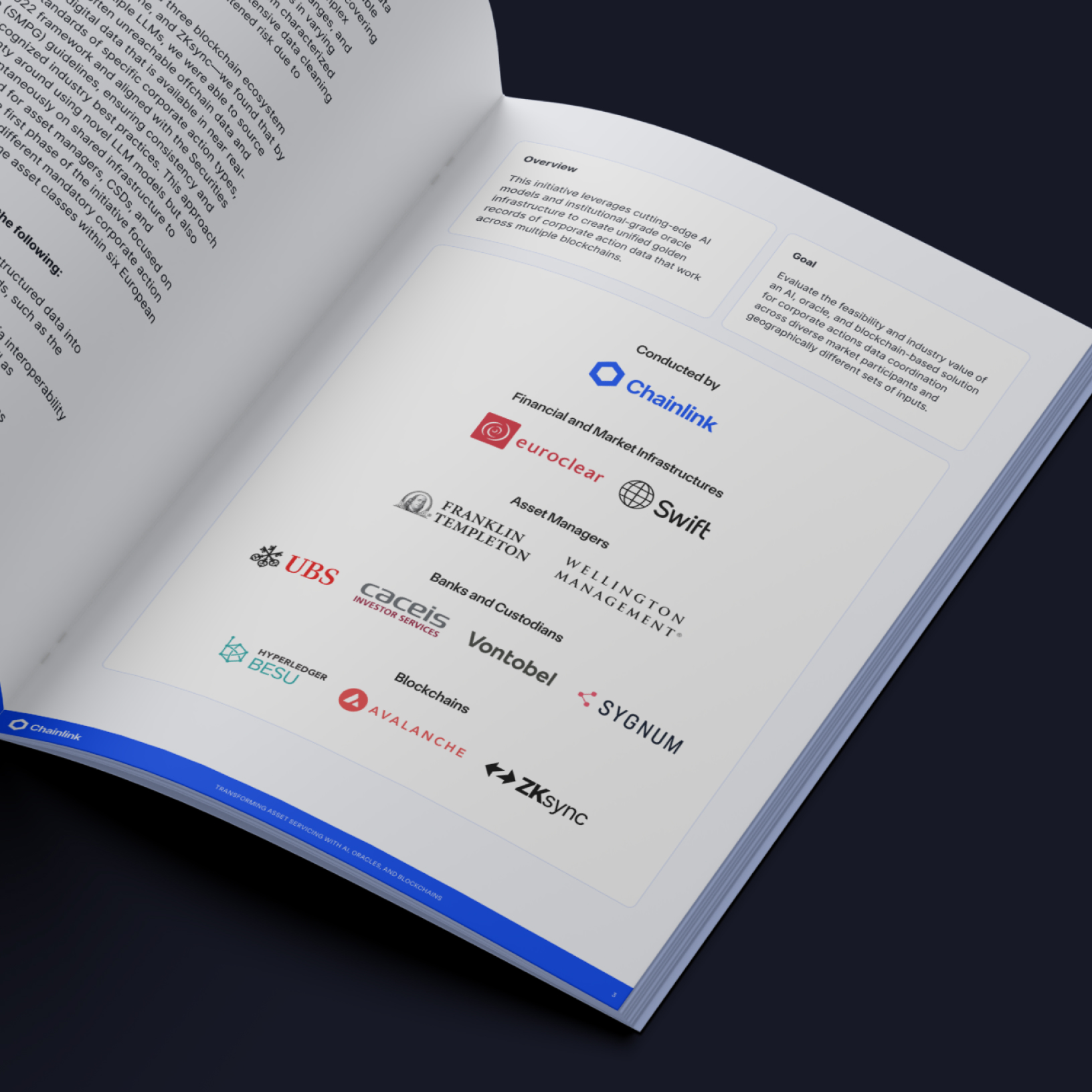Unstructured Data in Global Finance: Solving a Decades-Long Industry Problem With AI, Oracles, and Blockchains
Corporate actions are integral to capital markets’ day-to-day operations, facilitating dividends, mergers, stock buybacks, and other processes that underpin corporate governance and capital allocation.
However, communicating corporate actions to shareholders is plagued by costly errors, resource-intensive and duplicated practices, and unnecessary complexity as they are passed from issuers down a chain of various intermediaries, largely because they lack a verifiable structured data output that serves as a single source of truth for all market participants.
What Are Corporate Actions?
Corporate actions consist of any event or activity taken by a publicly traded company that may have a material impact on its capital structure or financial position, which needs to be shared with investors, asset managers, and other stakeholders. In the US alone, there are over 3.7 million event announcements every year.
While corporate actions include a wide variety of events, they are typically grouped into three categories based on shareholder participation:
- Mandatory actions where the flow of event information is strictly one way, from issuer to investor. Examples include cash dividends, stock splits, and mergers.
- Mandatory actions with options where the communications flow is bidirectional, with information flowing downstream from issuer to investor and instructions on which action to take flowing back upstream from investor to issuer. Examples include selecting between cash or stock dividend options.
- Voluntary actions are either one-way or bidirectional, depending on whether the shareholder responds to the corporate action. Examples include optional dividends and rights issues.
These events dictate the governance of the world’s largest corporations and the flows of trillions in capital, making them fundamental to the modern market economy and efficient capital allocation.
What’s the Business Cost of Corporate Actions?

Inefficiencies in corporate action processing are costing each market participant $3-5 million a year on average, according to a survey by The ValueExchange with the support of ISSA, and potentially hundreds of millions at a corporate level. A key reason for the costly inefficiencies is that 46% of event data is processed manually.
Direct losses due to processing errors can be even more costly. Over 45% of brokers have experienced a $1M+ loss due to errors, with some losses costing tens of millions. However, the opportunity costs of traders receiving timely and accurate corporate actions data are likely much higher.
The Corporate Actions Data Problem
1. Unstructured data
Corporate actions data can often only be found in PDF documents that can be hundreds of pages long, written in complex language, and without structured data tables. This is because there is currently no standard way that issuers announce events or a single universally accepted securities identification system.
2. Complex information flows
A corporate action life cycle consists of long and complex steps. Multiple intermediary institutions are involved, including custodians, data providers, exchanges, banks, central counterparties clearing houses (CCPs), and central securities depositories (CSDs), which increases the possibility of errors and anomalies creeping into datasets as information is passed along the communications channel.
3. Various data requirements
There are over seventy different types of corporate actions with various data requirements for each. Requirements are likely to increase as governance, capital, and regulatory structures become more complex, especially around ESG.
4. Human errors
Errors increase when humans are involved, often due to simple manual data entry mistakes or the misinterpretation of complex events. This is especially common on upstream information flows when systems are frequently replaced by ad-hoc emails, calls, and faxes. Currently, entities responsible for failures are often not held liable.
“As much as ‘it feels very 1980s to still be processing corporate actions on paper’ the practice is amazingly widespread.” — The ValueExchange
Industry Impact
1. Unconfirmed data
Intermediaries and investors cannot easily verify the truth in corporate action events. The responsibility usually falls on each recipient in the communications chain to compare and clean the data before they can make an informed decision, although they cannot truly verify its accuracy. Costly efforts to verify data include manually reviewing data in “8-eye checks,” internal “scrubbing” practices, and paying to access multiple data sources.
2. Delays
Manual reviews lead to delays in communicating events to investors and reducing the time they have to make informed decisions or act on timely information, which can have an outsized impact on traders.
3. Significant trade reconciliations
The cumbersome reconciliation process of comparing data across several providers results in trade or pricing errors that need to be reconciled across business units or between firms. Additional and unexpected work hours to reconcile these errors are significant, including from senior management.
A Novel Solution: Onchain Golden Records for Corporate Actions

A recent industry-wide initiative conducted by Chainlink, Euroclear, Swift, and 6 major financial institutions demonstrated howAI, blockchains, and Chainlink enable institutions to overcome the lack of structured real-time data for corporate actions. Critically, this solution doesn’t require the entire industry to transform its current operations to produce communications in accordance with new standards.
Previous corporate action initiatives have focused on the standardization of corporate action event communications by issuers and agents—requiring organizations across various countries to alter their current processes. In contrast, leveraging AI, oracles, and blockchains enables current unstructured data within corporate actions communications to be automatically processed to produce a structured output that’s easily accessible on a blockchain by all market participants and verifiable in real-time, enabling organizations to automate their corporate actions processes, minimize errors, and trade on timely, verified information.
Specifically, large language models (LLMs) are able to quickly extract structured data from unstructured data contained in initial announcements, despite announcement PDFs being highly inconsistent and containing a mix of text and tables. Chainlink is able to reliably and securely intake structured data from multiple LLMs and come to consensus on the event data, mitigating risks around AI hallucinations. Chainlink then delivers it to blockchains to create a single, verifiable source of truth—an onchain golden record—from which data can be disseminated across various blockchains and traditional offchain systems.

Together, AI, blockchains, and Chainlink can produce onchain golden records for corporate actions that are:
- Structured—Data in the Onchain Golden Records (UGR) can be stored in a structured format that makes it seamless for other systems to ingest it into automated processes.
- Timely—UGRs are accessible by all participants, and any near real-time updates are reflected in the UGR with timestamps.
- Accurate—A single source of truth removes the opportunities for errors as data is passed between participants.
- Verifiable—The authenticity and provenance of data can be verified by all stakeholders.
- Secure—Blockchains and Chainlink provide the most secure infrastructure available for storing and communicating financial data.
- Updateable—UGRs for mandatory or voluntary actions can be updated with investor instructions, such as voting on a merger.
- Accessible—All market participants from CSDs to investors can access the UGR in real time.
Explore Chainlink’s recent initiative streamlining corporate actions with AI, blockchains, and oracles: Transforming Asset Servicing With AI, Oracles, and Blockchains.
Beyond Corporate Actions: Expanding the Use of Onchain Golden Records As the Standard Format for Financial Data
Streamlining corporate actions using AI, blockchain, and Chainlink is a significant step on the path toward an onchain finance future with superior risk management, reduced information asymmetry, enhanced programmability, and dramatically more efficient operations. Onchain golden records sit at the core of this transformation, providing a verifiable, single source of truth for financial instruments, products, and events that can be updated in near real-time. With UGRs, transparency, interoperability, and composability become intrinsic characteristics of the financial substrate.

